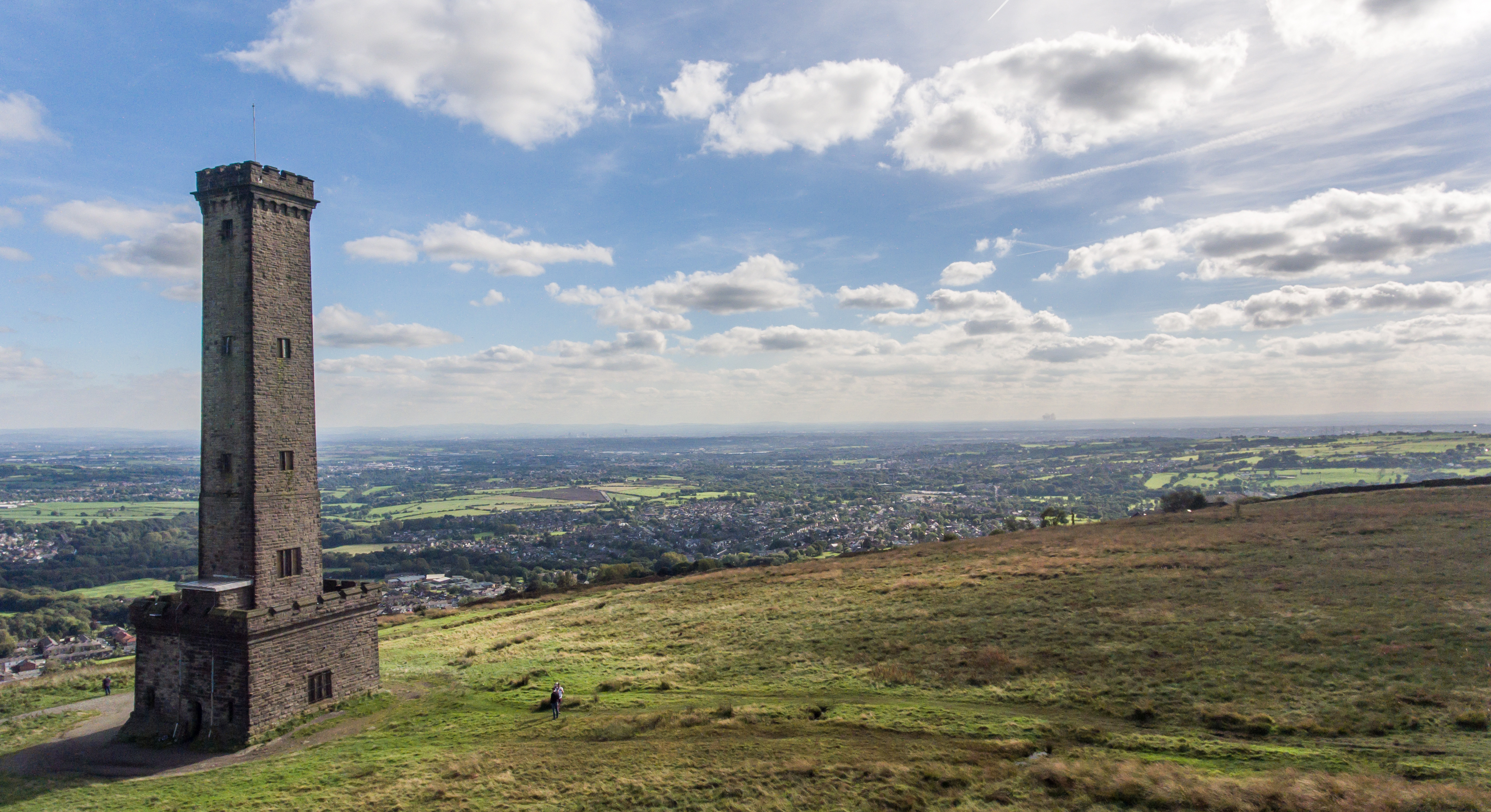Peel Monument on:
[Wikipedia]
[Google]
[Amazon]
:''See peel tower for the generic structure''


 The memorial tower to Sir Robert Peel, high above
The memorial tower to Sir Robert Peel, high above Bury Council reference to Holcombe Hill
due to its location next to Holcombe village) 1,100 feet (335 m) above sea level. The monument is believed to have been designed by members of the memorial committee who included the local textile entrepreneur and philanthropist William Grant. Grant was said to have been responsible for the site, which was in a direct line from his own house, Nuttall Hall and St Andrew's Church. A public subscription provided the £1,000 needed to build the tower. The stone for the tower was obtained from the hillside. The Peel Tower was opened in September 1852, the day after the inauguration of the Baily's statue in Bury. As at the earlier ceremony Frederick Peel was the principal guest of honour, and he declared the monument to be a splendid memorial to his father and to the principles of free trade. Local speakers included Joshua Knowles and John Robinson Kay. Unfortunately, large numbers who had travelled by excursion train from


 The memorial tower to Sir Robert Peel, high above
The memorial tower to Sir Robert Peel, high above Ramsbottom
Ramsbottom is a market town in the Metropolitan Borough of Bury, Greater Manchester, England. The population at the 2011 census was 17,872.
Historically in Lancashire, it is on the River Irwell in the West Pennine Moors, northwest of Bu ...
was planned and erected at the same time as Bury was preparing its statue to the then recently deceased statesman who was born in Bury.
The tower occupies a prominent position on Harcles Hill (known locally as "Holcombe Hill"due to its location next to Holcombe village) 1,100 feet (335 m) above sea level. The monument is believed to have been designed by members of the memorial committee who included the local textile entrepreneur and philanthropist William Grant. Grant was said to have been responsible for the site, which was in a direct line from his own house, Nuttall Hall and St Andrew's Church. A public subscription provided the £1,000 needed to build the tower. The stone for the tower was obtained from the hillside. The Peel Tower was opened in September 1852, the day after the inauguration of the Baily's statue in Bury. As at the earlier ceremony Frederick Peel was the principal guest of honour, and he declared the monument to be a splendid memorial to his father and to the principles of free trade. Local speakers included Joshua Knowles and John Robinson Kay. Unfortunately, large numbers who had travelled by excursion train from
Salford
Salford () is a city and the largest settlement in the City of Salford metropolitan borough in Greater Manchester, England. In 2011, Salford had a population of 103,886. It is also the second and only other city in the metropolitan county afte ...
arrived too late to witness the ceremony.
Inside the entrance to the tower is an extract from Peel's speech to the House of Commons in 1846. It emerged later that the tower had been planned and built in such haste that the necessary permission had not been obtained from the owner of the land, the Duke of Buccleuch
Duke of Buccleuch (pronounced ), formerly also spelt Duke of Buccleugh, is a title in the Peerage of Scotland created twice on 20 April 1663, first for James Scott, 1st Duke of Monmouth and second suo jure for his wife Anne Scott, 4th Cou ...
. This matter was eventually rectified in 1868 when the land was transferred into the keeping of six trustees, on the condition that it would not be used for contentious public meetings.
If the tower, in the words of the '' Manchester Guardian'', is not "a specimen of architectural beauty", it does provide a conspicuous landmark, and it also has a viewing platform from which to look across the surrounding countryside. The original internal staircase eventually became unsafe and was bricked up; later, the tower was reconditioned and a new staircase provided. The tower is high. A local Easter tradition entails people walking up the hill on Good Friday, often rolling hard-boiled eggs down the steep sides.
The tower was renovated in 1929 and at various other times. The tower closed after the Second World War
World War II or the Second World War, often abbreviated as WWII or WW2, was a world war that lasted from 1939 to 1945. It involved the vast majority of the world's countries—including all of the great powers—forming two opposi ...
in 1947 and was reopened and rededicated in November 1985 by Conservative Councillor Alice Maders.
The tower was then floodlit later that decade.
References
{{Buildings and structures in Bury Buildings and structures in the Metropolitan Borough of Bury Hills of the West Pennine Moors Monuments and memorials in Greater Manchester Robert Peel Tourist attractions in the Metropolitan Borough of Bury Ramsbottom